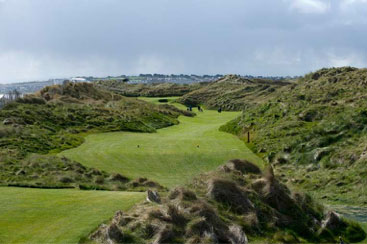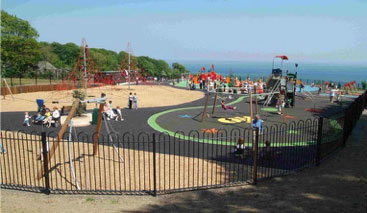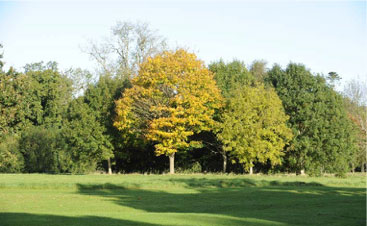Part 1: Setting the Scene: Scope, Definitions, Vision & Objectives
1.1 Introduction, Scope and Purpose

The purpose of this document is to define the appropriate strategy for the planning, development and sustainable management of public open space in Fingal. Currently there is no defined strategy within the Council for prioritising open space management and maintenance. This document brings together in a coherent way existing policies and practices and introduces new and innovative approaches to public open space.
A key concept in the strategy is understanding open space as part of Green Infrastructure. This Strategy seeks to improve open space provision through better management and to outline qualitative standards for the provision of existing and future open spaces. The main focus of this Open Space Strategy is publicly owned and/or maintained land, the primary use of which is for outdoor recreation and amenity in Fingal.
This document has been prepared in the context of the Government’s ‘Action Framework for Effective Local Government, Putting People First’ which sets out government policy on local government reform (see www. environ.ie).
Ardgillan Demesne Walled Gardens
The expressed vision of this reform programme as it relates to local government is as follows:
| “local government will lead economic, social and community development locally. It will be the main vehicle of governance and public service at local level, deliver efficient and good value services, and represent citizens and communities, as effectively and accountably as possible.” |
Workforce planning forms part of this action programme with local authorities directed to determine optimal local authority organisational and staffing arrangements within the context of a sectorial workforce plan.
The Council is working to ensure the sustainable provision of high quality public open space. There are limited resources and great amounts of land to be managed. This open space strategy, therefore, seeks to prioritise resource allocation whilst maintaining an appropriate standard of public open space provision for the citizens of Fingal.
This Strategy promotes community involvement, greater use of public open space, and more effective cross-departmental initiatives working in partnership with other agencies and stakeholders.
The Strategy references and builds on other relevant national and local policy documents including ‘Fingal Biodiversity Action Plan’, ‘The Forest of Fingal - A Tree Strategy for Fingal’ and the ‘Fingal Development Plan 2011 – 2017’.
1.2 Definition of Open Space
All open space is an important element of Green Infrastructure. The term ‘Green Infrastructure’ is used to describe the interconnected networks of land and water all around us that sustain environmental quality and enrich our quality of life. This includes the nature conservation areas, parks, open space, rivers, floodplains, wetlands, woodlands, farmland and coastal areas which surround and are threaded through our villages, towns and urban areas.
Open Space included in this Strategy
The focus of this Open Space Strategy is on the publicly owned and/or maintained land, the primary use of which is for outdoor recreation and amenity in Fingal. There are various typologies for this land including:
Regional Parks and Public Golf Courses
Regional Parks and Historic Demesnes are an important part of the landscape of Fingal. Examples include Ardgillan, Malahide and Newbridge Demesnes and major parks located along river valleys such as the Tolka and Ward River Valleys. They are all managed by The Council as an amenity for the public. Out of a total of approximately 2,000 hectares of open space in Fingal approximately 800 hectares is located in historic and designed landscapes. Many of these parks have historic properties and heritage buildings located within them which function as important cultural and tourism assets.
Regional Parks are large open spaces typically in excess of 50 hectares in area. They provide a range of facilities and features offering recreational, ecological, landscape, cultural or green infrastructure benefits. These parks include outdoor sports facilities and playing fields, children’s playgrounds for different age groups and areas for informal recreation pursuits.

Corballis Public Golf Course Donabate
There are three golf courses owned and operated by The Council. These are:
Elmgreen Golf Centre, Castleknock
( 18 hole Golf Course, 18 hole Pitch and Putt Course and 24 Bay Driving Range)
Corballis, Donabate
(public links golf course)
Malahide Demesne
(9 hole par 3 Golf Course and Pitch and Putt Course)
Local Parks and Residential Open Spaces
Local Parks are relatively large enclosed parks typically 20-50 hectares, located in close proximity to residential and town centre areas. These are usually very intensely used areas and are often the location for sports and recreational hubs.

Residential open spaces are provided within easy walking distances of homes and are available for formal and informal recreation. These open spaces are very diverse in terms of size, design, layout and land form. Boundaries are usually defined by the surrounding road and/or residential development.
These sites accommodate a wide range of usage patterns from active play and sport, through routes to shops and other amenities as well as more passive recreational purposes. Sites with a smaller area may be subject to conflict of interest, i.e. ball games close to residential properties, and sites with a larger area may be multi-functional and allow for a wide range of facilities and uses, i.e. equipped play and informal sports use.
These spaces may also have a nature conservation role, particularly in the preservation of trees and other important features.
Public Playgrounds
Playgrounds are outdoor areas for children’s play. They usually have a number of pieces of equipment. Within the Fingal area, they are located in Regional, Local and Neighbourhood Parks and within residential open space. There are currently 39 public playgrounds in Fingal.

Playground at Ardgillan Demesne
Environmental Open Space
This designation includes a wide range of open spaces generally located within residential areas. It includes approach routes into and out of villages and towns as well as space provided for visual set back and road realignment requirements.
These spaces are often visually significant and characterised by features or attractive areas that are not fully accessible to the public but contribute to the enjoyment of the space. They are often used to accommodate civic decoration or feature planting or decorative road signage.
Open Space not included in this Strategy
There are a number of types of open spaces not included in this strategy. This strategy recognises the importance of these spaces; however, they are dealt with in other the Council publications, i.e. ‘The Forest of Fingal - A Tree Strategy for Fingal’, ‘Fingal Allotment Strategy’, Public Realm Plans etc.
There are other open spaces managed and maintained by the Council which are not necessarily provided or used for recreation and amenity purposes. The maintenance and management of these spaces has nevertheless significant resource implications for the Council.
The following types of open spaces are not addressed in this strategy document:
Streets and Civic Spaces
These spaces provide important links between open space but are not open space in the traditional sense and are designed and managed primarily as transport routes (streets) and urban gathering places (civic spaces). The Strategy recognises that these are important public spaces where people meet, socialise and recreate complementing the use and values in the public open space network. Despite this use, it is recognised that there are a range of other strategies that guide the future planning, design and management of streets and urban spaces.
Schools
The Strategy recognises the contribution of schools especially where these can partner with Council open space. School land, however, will not be
added to the inventory of current open space or relied on as a replacement for public open space as school lands are not reserved for open space, are not under Council control and can be sold for other purposes.
Beaches and Coastal Walkways
The Strategy further recognises the importance of beaches and the coastal landscape in the Fingal area, however, the management of these lands is not addressed in this strategy document
Privately Owned Spaces
Privately owned open space, in many instances, contributes to landscape significance and habitat value in Fingal. Like streets and civic spaces, they may provide important links between open spaces but their long term availability and accessibility cannot be guaranteed unless they are acquired for open space purposes.
In addition to the Council identifying works on its own land, it is recognised that the Council has a strong advocacy role to improve the design and management of open space owned and managed by other agencies, such as schools and private clubs, through the County Development Plan and planning applications.
Other Lands not included in the Strategy
Other lands not included in this Strategy include Graveyards and Church Lands, Institutional Lands and Public and Private Allotments.
1.3 Vision and Objectives for Open Space Provision
The vision of this Open Space Strategy is to:
| "Provide a diverse, network of attractive, sustainably managed open spaces to enhance the quality of life of the citizens of Fingal”. |
Objectives
The objectives of the open space strategy revolve around the following five major themes: Value, Quantity, Quality, Sustainability and Conservation & Protection.
|
(1) Open Space Value |
The strategy outlines the health, social, economic and environmental benefits of open spaces. Parks and open spaces provide communities with a focal point for social interaction and cultural activities. Using parks and open spaces for events, festivals and other activities increases the value of open spaces. Promoting healthy, active lifestyles and encouraging events in open spaces are ways to increase the use and benefits of open spaces. Greater usage of open space will be achieved by making them more multi- functional, with a range of attractions and facilities for people of all ages and abilities.
|
(2) Open Space Quantity Provide a network of diverse open spaces |
Open space is an important element of Green Infrastructure in Fingal. Connecting our urban open spaces and the surrounding more rural open spaces to each other and to the communities around them will achieve a wide range of social, health, economic and environmental benefits.
|
(3) Open Space Quality Enhance the quality of open spaces |
This Strategy will outline how open space improvements will be programmed to enhance their quality and utility and will focus on improving access to and within open spaces.
|
(4) Sustainable Open Space Provide well maintained and managed open spaces having regard to available resources |
The provision of well-maintained and managed open spaces is essential.
This Strategy outlines how this will be achieved in a sustainable manner having regard to available resources. Significantly, this Strategy will establish a hierarchy of maintenance of open space to address risk management, usage pattern and amenity value of the open spaces in question.
|
(5) Conservation and Protection Conserve the natural and manmade heritage in our parks and open spaces |
